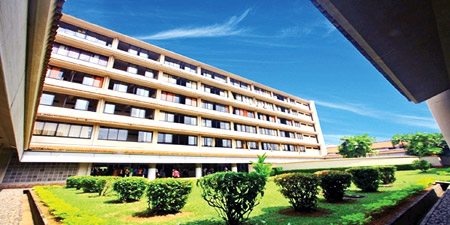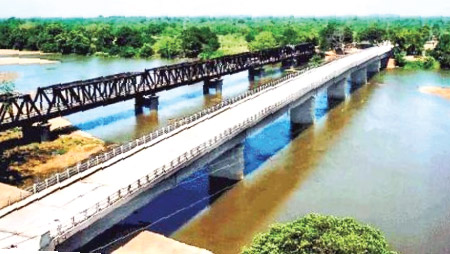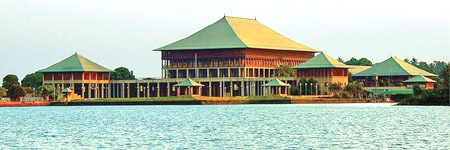|
President Mahinda Rajapaksa and Japanese Prime
Minister to launch Phase II Stage 2 of BIA today:
BIA expands gateway to Sri Lanka
 |
|
Prasanna J. Wickramasuriya,
Chairman Airport Aviation
Services Limited. |
Envisioning Sri Lanka as an aviation hub marked a turning point in
the approach to the development of the national aviation industry. The
Mahinda Chinthana envisions a development plan well integrated with
other economic activities. It also aims at decentralising the
development activities across the island so that their benefits will
flow down to all citizens. This includes the development of existing
airports, the setting up of new airports, air - sea travel integration,
making air travel more.
The hub status in aviation is based on the strategic location of Sri
Lanka with respect to the International air routes. Sri Lanka is located
midway between the aviation hubs in the Asia - Pacific region and the
Middle East. It is also located close to the equator.
This coupled with an exemplary safety record and state of the art air
navigation services makes Sri Lanka a natural candidate for an aviation
hub.
Bandaranaike International Airport
The Bandaranaike International Airport (BIA),is the first
International Airport in Sri Lanka and was the only International
Airport until the commissioning of the Mattala - Rajapaksa International
Airport (MRIA) in March 2013. It has been the main international gateway
that linked Sri Lanka to the rest of the world, economically, socially
and politically.
The construction of an airport in Ceylon that could cater to
international air traffic was first considered in 1939. However the
historic decision to convert the Royal Ceylon Air Force Base at "Katunayake"
to an International Airport came only in 1958.
This was the time the international aviation industry was
experiencing its first post war boom. In 1964 work began to modernise
the Katunayake airport to handle international traffic and by 1968 the
airport had the capacity and all the basic facilities required at that
time to promote and sustain international operations. Given the
strategic location of Ceylon, the airport soon etched itself firmly on
the world map and it was not uncommon to witness even heads of states in
the east using the Katunayake airport regularly for transit. The
national carrier 'Air Ceylon' also shifted its home base from Ratmalana
to Katunayake.
In 1976, Sri Lanka was making urgent preparations to host the summit
of the Non-Aligned Movement which was scheduled to bring a large number
of heads of states to Colombo.
The airport was given a facelift to convey an image of national pride
and also the technological upgrades to ensure the safety and reliability
requirements of the arriving heads of states.
The liberalisation of the economy and the boom in the tourism
industry brought about a steady increase in the passenger movements and
a need for streamlined, state of the art cargo operations. The national
carrier re-launched under the name 'Air Lanka' commenced operations in
1979 using BIA as its home base. To cater to the rapid increase in the
operational demands in all fronts a master plan was drawn up for the
development of BIA in a phased manner based on the forecast growth of
passenger and cargo movements.
The year 1983 was an important turning point which saw the operation
of BIA being entrusted to Airport and Aviation Services (AASL), a fully
government owned company. Airport and Aviation Services took upon itself
the task of implementing the phased development project for BIA as a
matter of priority. Accordingly Phase I of the BIA development project
was launched.
Construction work commenced in 1984 and the bulk of the work was
completed by 1988.
 |
|
Sri Jayawardenepura General Hospital
was completed with the grant of 8.5 billion
Yen from Japan in September 1983 as the
foremost medical hospital in Sri Lanka. The
General Hospital contributes to educating
nurses by coordinating with the National
SJDP Nursing School which was also completed
with Japanese grant in May 1999. |
 |
|
The Japan Friendship Peace Bridge
constructed over the Mahaweli river at
Manampitiya. The bridge constructed
at a cost Rs. 1.3 billion and partlyfunded
by the government of Japan is
302 metres in length and 10.4 metres in
width. |
 |
|
The Parliament Building Complex at Sri
Jayawardenepura, Kotte was built in 1982 |
Under this phase a new runway was constructed parallel to the
existing runway and the existing runway was converted to a parallel
taxiway. The terminal was expanded, a maintenance complex and a
navigational services complex with a new Air Traffic Control tower were
commissioned and the fire services were upgraded. Parallel with these
developments, the existing navigational aids were replaced and the
visual landing aids were upgraded. The customer interface too was
improved with duty free shopping, improved parking facilities and exit
transport services.
Cargo handling facilities were also tremendously improved to support
the rapidly developing freight forwarding and logistics industry. To
face the global threats to civil aviation, state of the art passenger
and baggage screening facilities were installed and a well-trained
security service was deployed in operation.
The escalation of the separatist war in Sri Lanka exerted a heavy
toll on the aviation industry. BIA was always a top target and in 2001
the separatist terrorists staged a devastating attack and crippled the
operations of BIA destroying the fleet of the national carrier along
with vital airport infrastructure.
The period that followed were shadowed by dark clouds of uncertainty.
Amidst these, competition from the region was intense with many new
international airports coming up.
Phase II Stage 1
To regain its status in the face of stiff competition, the first
stage of Phase II of the BIA development plan was launched in 2003 with
assistance from Japan through the Overseas Development Assistance (ODA)
program.
This stage brought state of the art facilities of international
status to the airport with a finger pier containing gates with boarding
bridges and expansions to the terminal. It was the introduction of
boarding bridges to Sri Lanka. The other additions were a Secondary
Surveillance RADAR System, Terminal Information System and
Meteorological Monitoring Systems. At the completion of this stage in
2005 the passenger handling capacity of BIA improved to six million
movements per year.
In addition to the enhancement to the capacity and operational
safety, operational efficiency was also improved on completion of Stage
I. The turnaround time for all types of aircraft were improved. The BIA
figures conform to industry standards.
Phase II Stage 2
In 2009, with the decisive defeat of LTTE terrorism President Mahinda
Rajapaksa ushered in peace to the island. With the dawn of peace air
travel to Sri Lanka surged upward and the capacity limits of BIA were
soon exhausted. The increased tourist arrivals included those from the
Far East. Several more airlines commenced operations to BIA. The annual
passenger movements through BIA exceeded the designed figure of six
million in successive years starting from 2011.
Under the second stage of the second phase of the BIA development
project that will be launched today (7), the capacity is to be increased
to 15 million passenger movements per annum. An additional finger pier
will be constructed to the west of the existing one. A two tier
passenger terminal with arrivals and departures physically separated as
found in most modern airports will also be constructed. A rapid exit to
the Colombo Katunayake Highway will be provided directly from the
terminal. Stage 2 itself is to be implemented in two stages and the
first stage is scheduled to be completed by early 2017.
The Japan International Cooperation Agency (JICA) is providing
assistance for this stage with the loan agreement being signed directly
with Airport and Aviation Services (Sri Lanka) Ltd.
Once the Phase II Stage 2 of BIA development is complete it will
stand as a monument of this lasting friendship.
President Mahinda Rajapaksa and Japanese Prime Minister Shinzo Abe
will jointly launch the project at 1 pm today, thus marking another
milestone in Sri Lanka's journey towards achieving hub status in
aviation as envisioned in the Mahinda Chinthana - vision for the future,
ushering in the golden era of the Sri Lankan aviation industry. |

